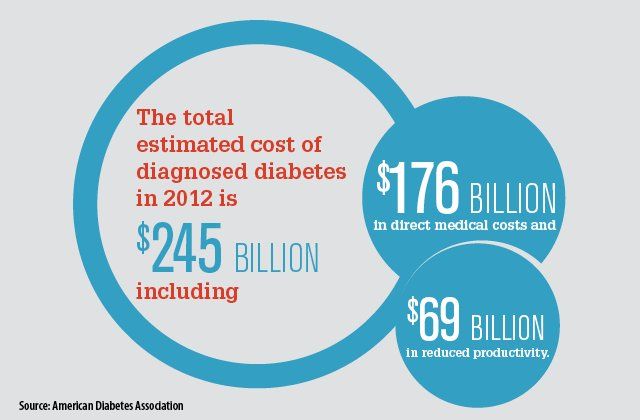- Drug Coverage
- Hypertrophic Cardiomyopathy (HCM)
- Vaccines: 2023 Year in Review
- Eyecare
- Urothelial Carcinoma
- Women's Health
- Hemophilia
- Heart Failure
- Vaccines
- Neonatal Care
- NSCLC
- Type II Inflammation
- Substance Use Disorder
- Gene Therapy
- Lung Cancer
- Spinal Muscular Atrophy
- HIV
- Post-Acute Care
- Liver Disease
- Pulmonary Arterial Hypertension
- Safety & Recalls
- Biologics
- Asthma
- Atrial Fibrillation
- Type I Diabetes
- RSV
- COVID-19
- Cardiovascular Diseases
- Breast Cancer
- Prescription Digital Therapeutics
- Reproductive Health
- The Improving Patient Access Podcast
- Blood Cancer
- Ulcerative Colitis
- Respiratory Conditions
- Multiple Sclerosis
- Digital Health
- Population Health
- Sleep Disorders
- Biosimilars
- Plaque Psoriasis
- Leukemia and Lymphoma
- Oncology
- Pediatrics
- Urology
- Obstetrics-Gynecology & Women's Health
- Opioids
- Solid Tumors
- Autoimmune Diseases
- Dermatology
- Diabetes
- Mental Health
Diabetes cost projections raise alarm bells
Spending on healthcare can be good, but in the case of diabetes, more spending likely means worsening outcomes.
Diabetes is a prevalent and costly condition. In this essay I will put it into perspective in terms of contribution to overall health expenditures and to the entire U.S. economy. Considering the amount of money spent on diabetes, there is an opportunity for healthcare providers to assume more responsibility and receive more rewards for the care of people with diabetes.
Health Affairs recently published an article on projected healthcare expenditures through 2024. Important projections include a further shift toward government payment through Medicare and Medicaid, and an increase in the percentage of Gross Domestic Product (GDP) devoted to healthcare from 17.4% to 19.6%. Total expenditures are expected to top $5.4 trillion.
Although no disease specific projections were included, we can estimate the impact that diabetes will have on overall cost based on the American Diabetes Association Scientific Statement from 2012. In the 2012 report the estimated direct cost of diabetes care was $176 billion.

If we apply a 4% growth rate (consistent with the Health Affairs report) that $176 billion will have grown to over $197 billion and likely is over $200 billion for 2015. If diabetes expenses grow at the same rate as overall costs, we can expect diabetes healthcare to consume 1.2% of the GDP by 2024. This is equivalent to the percentage of GDP attributed to agriculture and fisheries.
These numbers are big enough to make us pause and think. Spending on healthcare can be good-higher expenditures on cancer care are linked to better outcomes-but in the case of diabetes, more spending likely means worsening outcomes.
More people with significant end organ involvement are suffering complications of therapy such as hypoglycemia. Approximately one-third of nursing home and residential facility days are used by people with diabetes. And diabetic patients use 43 million bed days per year in acute-care hospitals.
Next: Lowering cost, improving quality
Lowering cost, improving quality
There are clearly things we can do to lower costs and improve care. Forty three percent of expenditures attributed to diabetes are for hospital inpatient stays while only 8% of expenditures are for physician office visits and 18% of expenditures are for medications. Surely we can shift the balance away from rescue and problem solving to proactive intervention and preventing or delaying disease progression.

With diabetes becoming a significant portion of the national economy, it should also become a focus for investment. Over 59% of diabetes patients and a much larger portion of diabetic costs are born by Medicare and Medicaid. This should make diabetes a national priority. But, we should not wait for federal action.
Diabetes services, medications and labs are all covered by both commercial and government health plans. Providers, and in particular those providers who are accepting risk through value-based arrangements should be organizing to manage the care of these patients in a patient-centered and evidence-based manner. This is a huge opportunity for providers who must transition from fee-for-service and bed days to population health and outpatient care.
There is a lot of technology available to help people who have diabetes. This ranges from new pharmaceuticals to devices to mobile apps. No one of these items will cure or fix our diabetes problem. However, using a combination of these in a thoughtful way and in the context of basic good medical care can make a difference. The real problem is not lack of funding (we pay plenty for diabetes care) or lack of technology, but lack of organization and focusing on what really matters before the patient progresses to hospitalization.
Edmund Pezalla, MD, MPH, is the section editor for Managed Healthcare Executive's Diabetes Health Management topic resource center. Pezalla is vice president and national medical director for pharmaceutical policy and strategy, Aetna.
Doing More and Saving More with Primary in Home Care
September 1st 2021In this week’s episode of Tuning In to the C-Suite podcast, MHE Associate Editor Briana Contreras interviewed VillageMD’s Senior Medical Director of Village Medical at Home, Dr. Tom Cornwell. Dr. Cornwell discussed the main benefits of primary care at home, which includes the benefit of cost savings for patients, maintaining control of hospital readmissions and others. Dr. Cornwell also noted what has changed in the industry of at-home care and if there has been interest from payers like insurance companies and medicare in the service.
Listen
This week on Tuning Into The C-Suite Briana Contreras spoke with Dr. Scott Hayworth, president and CEO of New York-based CareMount Medical. In this interview, the two discussed the importance of patients staying in contact with their doctors for the sake of reducing public health risks and to discuss ongoing care options with them.
Listen
